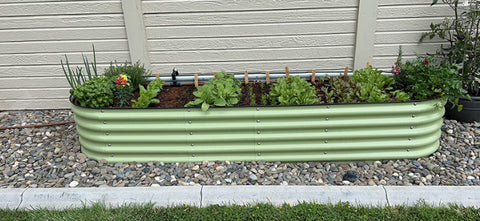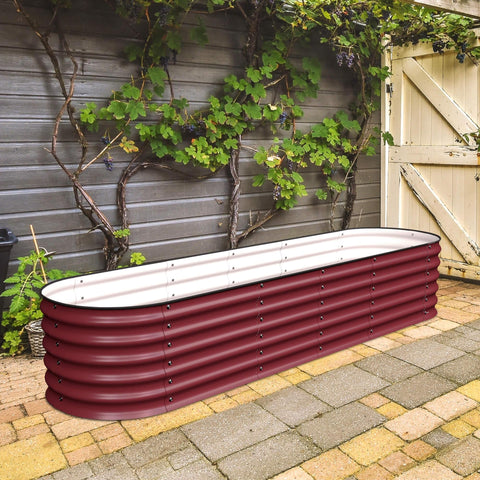6 Benefits of Raised Vegetable Garden From Olle Garden Bed
The raised garden bed is an over-ground structure, where you can plant various plants, especially vegetables! It also provides solutions to many gardening problems, whether you need more space or are not able to move. Our protruding gardens provide more than just delicious vegetables throughout the year.
They are easy to DIY, and the materials are usually reasonably priced. In addition, the raised garden bed is an ideal place to grow vegetables and flowers. If you've never planted vegetables on a raised garden bed before, it's time to start, for many reasons. Learn all the ways that a raised garden can help you do your gardening!

Better drainage
If the soil in your garden tends to retain too much water, consider using raised garden beds - they are known for promoting better drainage. Vegetables such as brassica, root crops and green leafy vegetables need adequate drainage to thrive. Some plants, such as tomatoes and pumpkins, are easy to get sick when they are watered too much.
Use your own light loam to prevent your garden from flooding, thus protecting the roots of plants. Most importantly, you don't have to worry about soil erosion during heavy rains, as it is all contained in the garden bed.
Additional growth space
The great thing about raised garden beds is that you can build them anywhere. Therefore, if you don't have much space in your garden, you can easily build beds in terraces, sidewalks, or places with poor soil quality. You can also plant more compactly and use vertical planting techniques on elevated beds, which means fewer weeds will enter your garden.
It's also easier to walk around the garden bed without having to watch your step and worry about compacting the soil. Just remember to keep your elevated bed away from the public walking space!
Soil quality
If you live in places with rocks or clay, or in areas that may be sloped or uneven, a raised garden bed may be your solution. You can build them to create a flat and uniform growth space. In addition, use high-quality soil with good drainage to create a perfect environment for your vegetable plants.
Soil is one of the most important parts of your garden. As a general rule of thumb, loose, well drained and nutrient rich soil is the best choice. Look for a mixture of clay, sand and organic matter, or try making it yourself!
Because you fill it with your own soil, you can easily add different soils and modifiers, such as fertilizer and compost. This ensures that your plants are well nourished and well drained. When the next season comes, you can test the soil ph and add any necessary amendments.
Professional tips: use companion plants to grow vegetables to improve soil quality and yield. Many companion plants can also prevent pests to make your vegetables as healthy and happy as possible. Examples include basil and tomatoes, beets and spinach, carrots and lettuce.
Better temperature
As the garden bed is higher than the ground, the soil will warm up faster in spring. This is ideal for extending the growing season so you can start planting faster. Instead of waiting until the warm days of spring, it is better to plant green leafy vegetables, root vegetables and brassica.
You can also install a transparent cover to create a cold frame. You can use it to overwinter perennial plants, adapt to seedlings in early spring, and extend the growing season from autumn to early winter. You can continue to plant hardy plants such as potatoes, radishes, and spinach until the temperature becomes too cold.
Prevention of pests
If you encounter problems with pests such as rabbits, a raised garden bed is also a good solution. These creatures will not be able to enter your plants because the garden bed barrier blocks them. You can also reinforce the bottom of the unit to prevent hamsters and moles from entering your plant. Finally, adding row coverings on top of plants can protect them from pests such as cabbage worms.
Professional tips: Although rabbits and deer like to chew beans and lettuce, you can also prevent them by planting rosemary and chives nearby.

Low maintenance cost
Because you can better control what grows in the garden bed and keep it compact, there are fewer weeds, which means you have less maintenance. Most importantly, because the bed is on the ground, you don't have to kneel down or bend uncomfortably to solve problems such as back pain and leg cramps, and it is easier to recover the harvest!
If you build raised garden beds with four walls and reinforced bottoms, they may also be temporary. This is the ideal choice for renters or anyone with limited garden space.
Things to remember
Although the raised garden bed has many advantages, there are still some things to remember. Although the garden bed itself can save space, if the space is small, you may not have space to place the garden equipment you want to use. In addition, the bed heats up faster in spring and provides adequate drainage, but this means you need to water more frequently in warm summer.
Large grape vegetables, such as pumpkin and tomato varieties, require a lot of space, so a raised vegetable garden may not be the best choice to accommodate them. Having said that, you can choose compact varieties and use the grid to guide them vertically.
Get Gardening
Raised gardens are an ideal solution to many horticultural problems, including maintenance, insufficient space, pests, and soil quality. All these benefits mean that your garden will be more productive because you can provide the best environment, nutrition and warmth for your plants.
